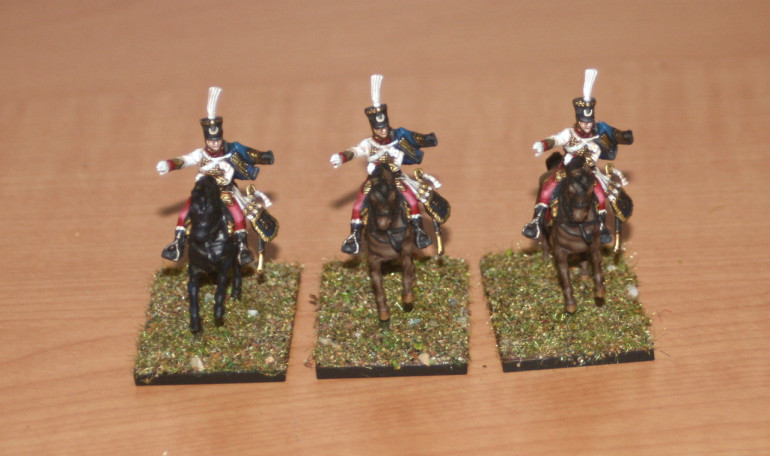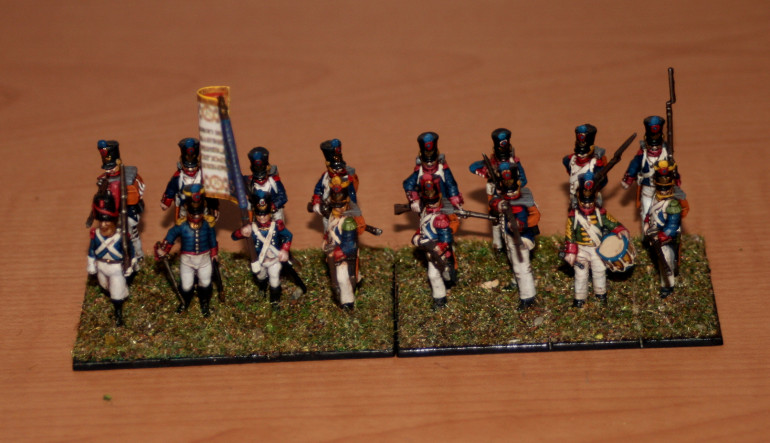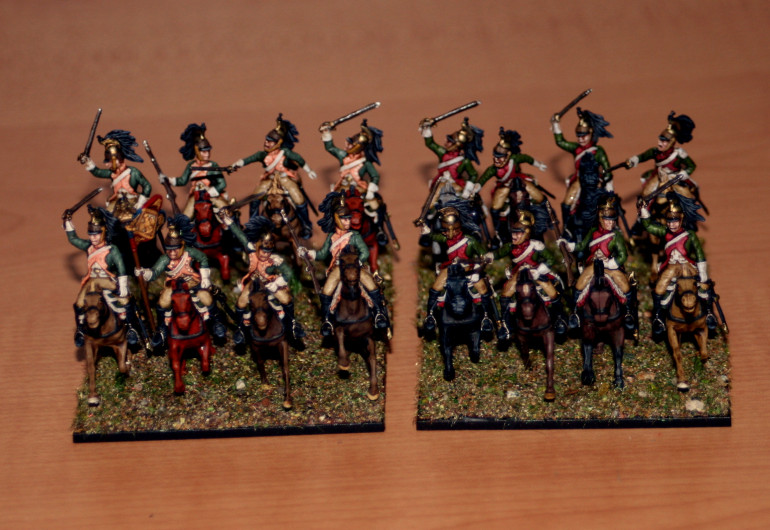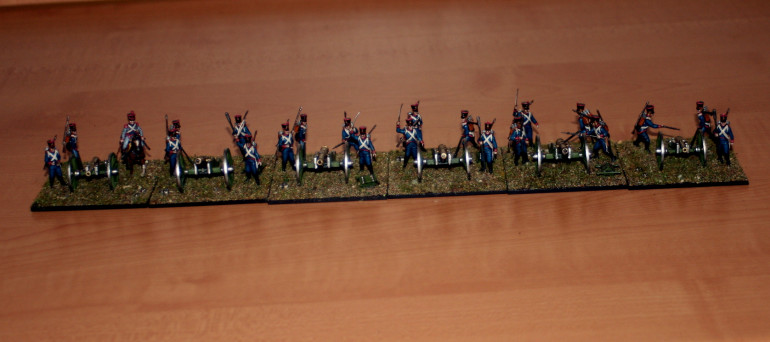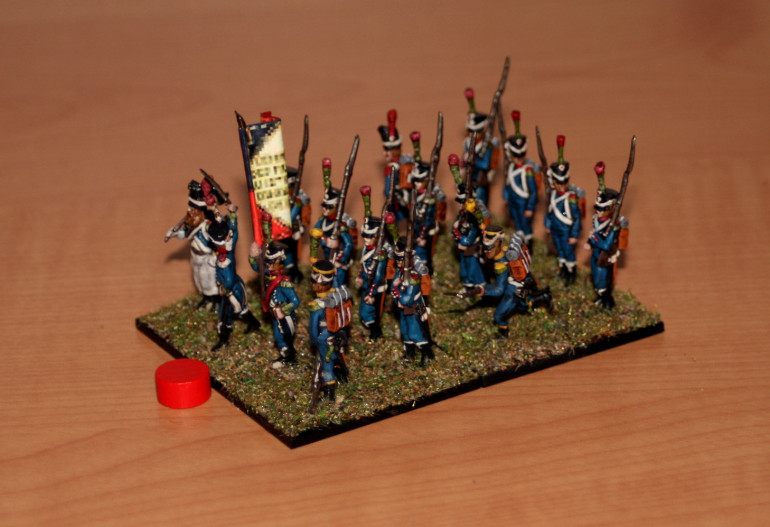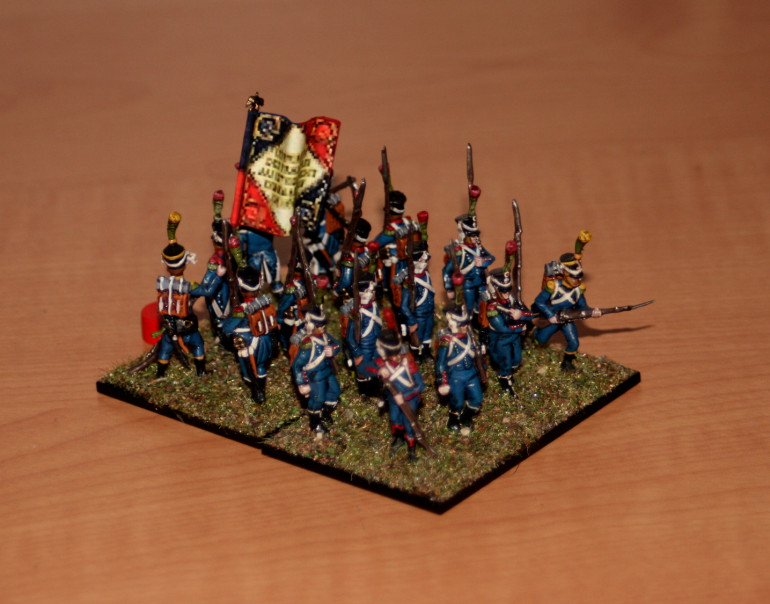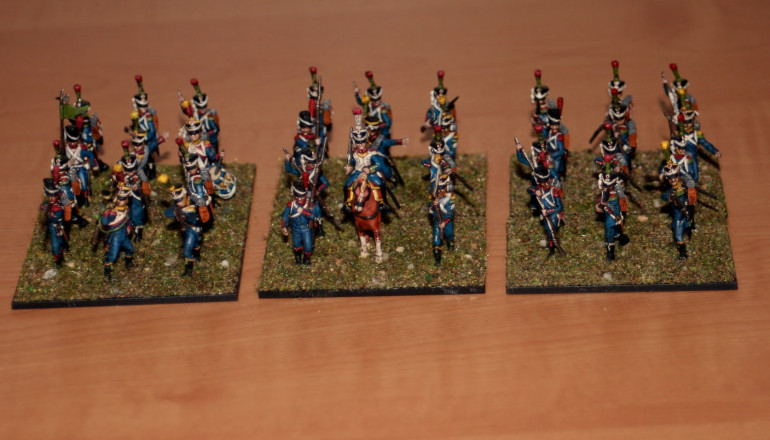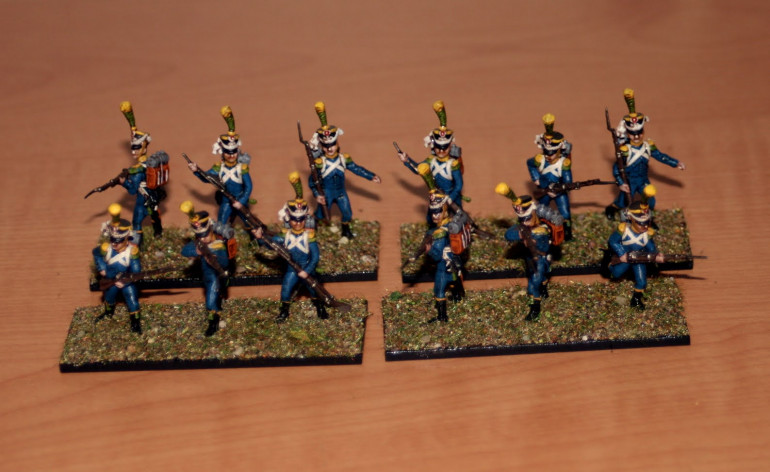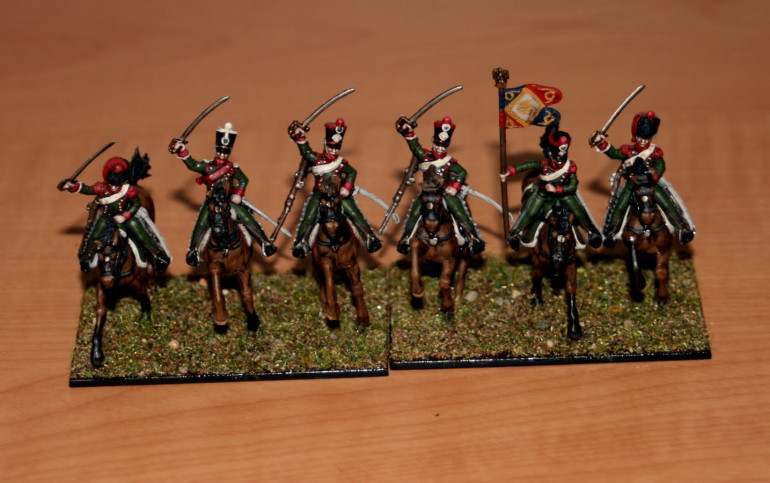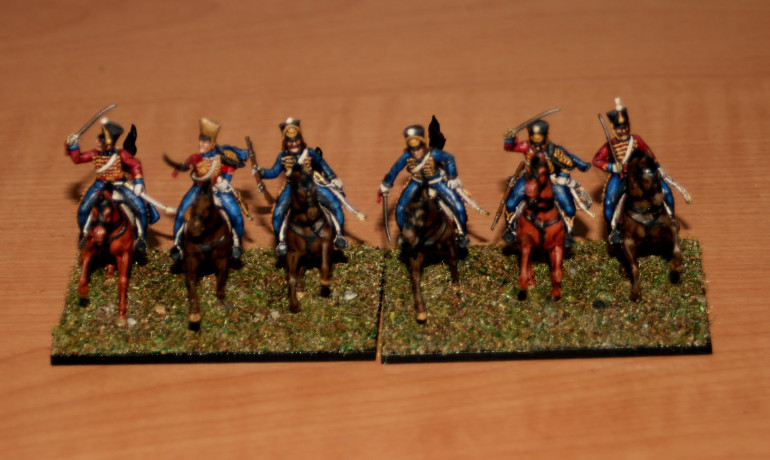
No Cheese! C’est Impardonnable
Recommendations: 260
About the Project
This is my 1/72 French Napoleonic army for DBN (De Della Napoleonicis) from KISR Publications. The project took me about 14 months to paint up and can be used with other wargame systems. I will gradually post pictures of all the unit types throughout the week as I get the time to take pictures and upload them.
Related Genre: Historical
This Project is Completed
An Army Finished.
I have been working on this army for a bit over 14 months. I have had the figures for much longer, but I finally decided to paint them up. I did so because I wanted to play DBN more. I initially wanted to build a 10mm or 15mm army, but at the time 1/72 was the most viable option – but just two days after I finished painting, Warlord Games come out with their Napoloenic Epic range! Talk about bad timing – but hey c’est la vie!
DBN is not my favourite Napoleonic wargame, but I have a very soft spot for it. It is easy to play, sets up quickly, cheap to buy into miniature model-wise and can be played within an hour and a half – if you know what you are doing.
It is one of the best time/space economic game systems in the Napoleonic range and worthy of consideration. It has its flaws and drawbacks, but I will discuss that on a different post.
Below I have some photos of the command stands I painted up for DBN, as well as other for other games.
Next up are the Fusiliers, the heart of any French army. I will try post them Friday evening.
Regards,
NR
The Core of the Army and My Approach to Painting this Army
Any Napoleonic army would be an empty husk without its Fusiliers. The fusiliers in my army belong to Italieri with a few exceptions. As you will see, some uniforms are pre-1812 Bardin Regulation change and some (like the fusiliers) are post-1812. So I decided to go for an 1812 army were both types of uniforms were present, To be honest though, I don’t really care that much.
If you look carefully you will notice that only half the fusiliers have flags. This is intentional. I did this in order to be able to play other game systems where I could use two bases for a battalion; were one would have the flag and the other not.
My Painting Approach and Philosopy.
When I began this army I decided on a few things or points I would follow – partly to remain sane and to manage a project over such a long period:-
- This was to be purely a gaming project. It was never meant to be a showcase army. Therefore it is meant to look good from a distance and not on close inspection.
- I was going to paint the troops with base colours and only one highlight and a wash for the lowlights and with emphasis on neatness. The generals will be a bit more elaborate with two or three highlights.
- I would try to set time aside and finish at least one base per week.
- The basing would be a simple flock mix.
- I was not going to fuss over the accuracy of excess details like uniform tubing or exact colouring of the clothing. If they look like fusiliers, then they are fusiliers.
I think this approach to army painting these cheap models served me well enough and the army is more than tabletop worthy. If you disagree please let know, I always enjoy listening to diverging opinions to my own (without judgement or prejudice!)
That’s all for today. Tomorrow I will post up one of my favourite troops – the Dragoons – Napoleon’s medium cavalry .
Regards,
NR
The Medium Cavalry
Unlike the Dragoons of Britain, the French Dragoons were a bit of a jack-of-all-trades. Sometimes called the poor man’s cavalry, they acted like heavy cavalry, but could also perform light cavalry duties. When without horse and saddle they acted like line infantry and also as dismounted cavalry when skirmishing.
In game terms they vary from rule set to rule set. In DBN they are classified as superior cavalry or inferior heavy cavalry. Some rulesets classify them simply as medium cavalry.
The French Dragoons are one of my favourite troops of the period, sharing the position with the Polish Vistula infantry and Lancers. I will be painting up more Dragoons for the third phase of this project when I start the French Imperial Guard. These dragoons are called Empress’ Dragoons and there are slight differences in their uniform which I will have to modify since there is no set available in plastic.
I will try to upload the cannonry in the next post. It all depends on time, but until then take care.
Regards,
NR
The Artillery
Artillery was a very important part in Napoleonic warfare, even more so when you take into account that Napoleon himself was an artillery man at heart – graduating as an artillery officer from the military academy at Brienne-le-Château.
It also plays an important role in wargames of the period and no less in DBN. The artillery are divided into two types – the heavy foot artillery and the lighter and mobile horse artillery.
The observant period gamer will notice that I did not paint the lining around the vest of the artillerymen. This was an oversight on my part. I actually intended to paint them but it just slipped my mind. I only noticed after gluing them on and basing everything.
The models are a mixture of Zvevda and Italeri sets. The infantry are Zvevda for sure, the equerry is Italeri but I cannot remember the manufacturer of the cannons.
It is not over for today. I will try to post again tonight, but I am not sure what I will go for.
So until then take care and game on.
NR
Converting To Other Systems
DBN is not a totally proprietary system. You can use your models in other systems quite easily with just a few conventions that both players must keep.
Although DBN is part of the DBX family, it does not use exactly the same basing system where infantry are concerned. Instead of 4/3/2 figures per base, DBN uses 8/6/3 figures per base for close infantry, open infantry and skirmishers. The frontage is always the same, usually 40mm or 60mm.
This gives a good basis for using your bases in other systems. It might be more representational with 16 figures per battalion, but that is the price that has to be paid.
Below are a few games I use this basing system for. Note that I have only listed the games I have played and know something about.
For Army Level Games
Army level games like DBN, Et Sans Resultat (ESR) and Blucher are perfect for this basing system. Each base is basically considered a brigade and every model a battalion.
For Brigade Level Games
These type of games are probably the most played and they consist of games like Black Powder, General D’Armee and General de Brigade, and Over The Hills. The latest game I have played is Absolute Emperor and it is a strange one! It is an army level game that plays much like a brigade level game – it is not everyone’s cup of tea, but can be used with this basing system easily.
In order to use this basing system you must use two bases together (you can use more and if you have the figures more is definitely better). With two bases you can imitate all the basic formations in these games – namely Line, March Column, Attack Column and Square.
In the pictures below I have some examples. Note that the red wooden marker denotes the front and centre of each formation for easier reference.
Please note that there are sets with figures posed for square formations. Instead of using the system above, you can build a square and just replace the two bases with the square, just keep the sides all the same length as the frontage. Unfortunately, I do not have a built-up example of this for the French, but I plan on doing this for the British for sure.
For Large Skirmish Games
The only large skirmish game I currently play is Sharp Practice, and I find that this basing system works just as well for it.
In Sharp Practice every model is a single man. A formation is formed from units of 8 models each for close infantry and cavalry, and 6 models for skirmishes. All you need to do is keep a wound marker behind each base since you cannot remove models physically – something like a small die is perfect.
This is how we learned to play the game, although I prefer to use 28mm models for Sharp Practice – I must admit.
So that is it! As you can see, building an army for DBN does not exclude you from playing other games. The basing system is flexible enough to accommodate three levels of combat. The only thing that stops you is your personal preference – something I completely understand and condone.
Next up are the light infantry. Until then stay safe and play on.
NR
The Light Infantry
The light infantry in my army are all from the Hat and Zvevda ranges. The uniform is from 1809 up to 1812. These are some of Hat’s best miniatures in my opinion, I recommend them to anyone building a French Napoleonic army in 172 scale.
In DBN, light infantry units can operate as close infantry or in open formation. Therefore I based them in two ways. The first was to base them as fusiliers, as seen below.
The second lot were based with only 6 figures per base instead of 8. This shows the light infantry dispersing and operating in an open formation. The bases also have a slightly longer depth as well (but the same frontage).
I also have units of voltiguers in skirmish formation. The first type with 3 figures per base is used in DBN (note the longer depth of the base). The second group I painted up for other brigade level games I play that require voltiguers to operate and detach from their formations. They also have 3 figures per base, but can also work with 2 figures per base.
That is all for my light troops, now it is time to add some colour with the allies. That, though, is for the next post.
Regards,
NR
Adding Colour To The French
In my opinion, no French army would be complete without the allied forces that accompanied and fought beside it.
They also add colour and spectacle to the army, unlike the boring (yet formidable) 1813-1815 Prussians.
For the first phase of this project I decided to paint up 12 bases of allies – 2 of each. This allowed me to form up 6 colourful battalions – each one from a different nation or region. I also chose them in a way as to make them as different in colour as possible from the French infantry.
The great thing about the allies is that you can use them in a battle (according to the rules of most games) as, and instead of French fusiliers – or militia later on.
I will be expanding on the allies during the third phase of this project when I start to tackle the Imperial Guard. I will add 4 more battalions to the Bavarians, 3 to the Nassau (so I can use them as allies for the British if I ever play the 100day campaign), and I will add several battalions of Italians, Wurtenburgers, and more Swiss.
Well that is all for today. Tomorrow morning I will try to post up the heavy cavalry.
Until then stay safe and game on.
NR
The Heavy Cavalry
Big men on big horse – is there anything else to say? The Cuirassiers and Carabiners were a terrifying sight to disorder or fleeing troops.
They were called ‘heavy’ mostly due to their formation during the charge and not not because of the breastplates they wore – which were only partially effective against musket shot.
I have used them a lot in games, but never very effectively. You really need to use them when the time is ripe and right. I, unfortunately am a very impatient tabletop general.
This post was short and sweet. Tonight I will try to post again.
Regards,
NR
Elite Line Infantry
In DBN, you are allowed to have ‘elite’ brigades. These are usually Young Guard or Vistula legion for the Peninsular War, but you can have combined Grenadier companies on occasion.
So I decided to go with the Line Grenadiers as my elite bases for DBN. This also allowed me to use them as battalions for games like Black Powder for example, as well as Grenadier formations for Sharp Practice.
I will be leaving the Young Guard and the Vistula for the Imperial Guard in the third phase of this project.
That is all for today. Tomorrow I will be posting my favourite of this project – the camps and baggage wagons.
Until then,
Regards,
NR
Supply Wagons, Camps and Making Merry!
A slight change of plans tonight. My shift was moved and swapped so I have time to post another entry into this project.
The next entry was the most enjoyable part of this project. In most DBX wargames (the ones I know of at least), you need to have a campsite or supply wagon on a slightly bigger base. DBN is no exception to this. This camp serves as a focal point for the enemy to ransack and the owner to defend.
In DBN, you must have one for every 12 points of troops. With the Imperial Guard, I will eventually have 36 points so I decided to build three right off the bat.
The first is a simple and common supply wagon, probably used by every nation involved in the war. The kit belongs to Italeri and comes as seen in the photo below.
The next is a French Napoleonic field ambulance from Hat miniatures. The surgeon and his team operating, and the grenadiers carrying the stretcher, are from an old Stretlets kit.
The last is a group of French soldiers making the best of a bad situation with music and plenty of alcohol. All the models in this scene are from the same Stretlets kit as the surgeon above.
I am quite happy with how these little diorama-like pieces came out, and I am quite fond of them. Unfortunately, I have not seen similar kits for the British. This means I might have to do some converting to get a similar result when I get around to doing Wellington’s boys.
That is definitely all for tonight. I only have two more posts to go.
Regards,
NR
The Light Cavalry
The light cavalry might not be my favourite troop type but they do come in at a close second, especially the Hussars. There is something inherently romantic about them – in an adventurous way. They also have long moustaches and wear pelisses. Gotta luv’ em!
Napoleon had three basic types of light cavalry in the regular army: Hussars, Lancers and the Chasseurs-a-Cheval.
First up are the Chasseurs-a-Cheval. Chasseurs were frequently used as advance scouting units providing valuable information on enemy movements. In DBN you are allowed to have 2 bases of scouts and they can be cavalry, so I went with the Chasseurs.
I will be painting up more Chasseurs for the Imperial Guard later on, so I went more with the other types of light cavalry. They are Italeri models.
Below are my Hussar regiments. I believe (and if memory serves) they are the 5th, 6th and 7th. All the Hussars are from Italeri.
I could not resist painting up the 7th Hussars. My favourite general, Antoine Lasalle, commanded these guys so they were an auto include.
The last, but definitely not least, are the breakers of the British cavalry – the Lancers. Contrary to common belief they did not always carry a lance into battle.
These lancers are from the company Waterloo 1815. The lances are a bit flimsy and brittle and they don’t have a lot of poses, but they are the best looking Lancers of the line on the market at the moment.
And there you have it, my French Napoleonic army of the Line at 1/72 scale for DBN and beyond.
My next and last post will be a very short article about the pros and cons of DBN. I might post it up tomorrow or the day after.
Best regards,
NR
DBN - A Simpler Way.
It is no secret that I truly enjoy the De Bella Napoleonicis (DBN) rule set. As I have said before, it is not my favourite Napoleonic game. On an army level, that accolade would go to Blucher. On a brigade level, I would have to say General D’armee.
Nonetheless, it is a game closest to my Napoleonic heart. I have a soft spot for this game that has never been surpassed by the others.
The question is – is it really any good; are there any drawbacks; do these qualities make it a game you might enjoy. Let’s take a closer look.
The Negative Side of the Story.
I want to start with the negative side and put it all out there from the onset. Let’s hang the dirty laundry for all to see.
- High Priced PDF: Yes, I believe the PDF is over-costed for what it is – a typed out document at £15. The printed version costs slightly more, and is basically the pdf in ring binding. The pdf should not cost more than £8 in my opinion for a 50 page rulebook.
- Wall of Text: This is a drawback endemic to all DBX games. Walls and walls of text. Let’s face it, people – and gamers – are lazy at times, and reading 50 pages of text is not that easy – especially with this ‘short attention span’ generation. The book needs to be presented differently for a modern gaming generation. It needs more photography, pictures and examples explaining game terms and rules.
- Very Representational: This is something common to all army level games. The gamer at this level should not be too interested in units forming squares and changing formations and with all the minutiae of the Brigade General. Also, in army level games, there are usually less figures than large scale battalion games. Hence there is less pomp and circumstance in army spectacle.
- Unpredictability: Like all DBX games, units and formations move according to the luck of a dice roll. One pip of a die means you can move one base or a formation of bases. The skill is found in trying to move as many bases with as few pips as possible while retaining your battle plan. This is not everyone’s cup of tea. Certain nations and generals can mitigate this, but not by much.
- Two Versions in One: DBN is in it’s 2nd version, but the rules still contain 1st version rules. These 1st version rules need to be removed from the main text and placed in an index at the back. To Mr. Testo and Mr. Carter, the 2nd edition is superior and better. It is time to move on and leave the 1st version rules behind.
The Posative Side of the Story.
There is a lot of good to this game, to the point that it supersedes the negative and has won me over and kept me playing. Let’s dive in:
- Easy To Learn: DBN’s motto is keep it simple, and that is exactly what is does while remaining a challenging experience. Unlike most DBX games, the rules are written clearly and in plain language.
- Period Flavour: Although these rules are simple and representational, they still retain period flavour and nations play as you would expect them too. like in other more detail game systems.
- Speed of Play: This game plays quickly. You can play a basic 12 point game in 40 minutes, including setup, if you know the rules well. For gamers like myself who can only afford to go once a week to the club for a few hours, this is the only way to enjoy a Napoleonic game in such a restricted timespan.
- Small Play Area: That is right, you only need a playing surface of 90cm x 90cm for a basic 12 point game for 1/72 figures. For scales of 18mm and smaller, 60cm x 60cm is more than enough.
- Small Model Count: I have mentioned above that the game is very representational, but this also has a bright side. It means you do not have to paint a lot of miniatures in order to play a basic game. A standard infantry or cavalry base costs 1 point, elites cost 1.5 points, militia cost 0.5 point and Old Guard cost 2 points. This means that for a basic army at 12 points you will have anywhere between 9 tp 15 bases in your army.
- Base Compatibility: I have already written ad nauseum about this above, but this system gives a very flexible basing system that allows one to play and enjoy other gaming systems at different levels.
Conclusions
First of all, I want to thank everyone who took the time to take a look at this project and especially if they had the patience to read what I wrote. I also appreciate those who clicked on the recommendation buttons as well. It is greatly rewarding to see the number rise.
I also hope some of you might fancy giving it a try, especially those of you who, like me, are time-restricted for whatever reason under the sun. You might find that it is an enjoyable compromise for Napoleonic wargaming.
For those who are interested, below are a few links:
The Website:
http://www.dbnwargaming.co.uk/
Information Videos:
https://www.youtube.com/channel/UCRRGeI_zhFpbY1PqdKWGZ4g
Finally I want to say a heart felt thank you to Alex Testo and Bob Carter for bringing this game to life.
Regards,
NR














































